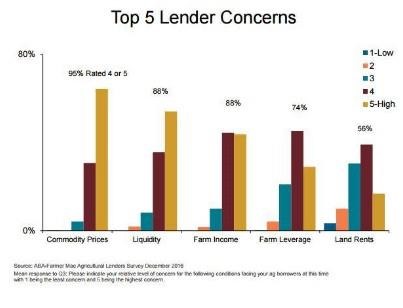Nearly 90 percent of agricultural lenders have seen an overall decline in farm profitability in the last 12 months, according to a joint survey by the American Bankers Association and the Federal Agricultural Mortgage Corporation (Farmer Mac; NYSE: AGM and AGM.A). The survey of more than 350 agricultural lenders representing institutions of all sizes across the country revealed that when it comes to their producer customers, lenders are most concerned about commodity prices, liquidity and farm income.

Farm Profitability
Ninety-five percent of lenders indicated commodity prices - particularly grains, beef cattle and dairy - are a top concern. While concerns about commodity prices varied by region, overall, lenders are most concerned about grains (80 percent rated it a four or five on a scale of one to five) followed by beef cattle (63 percent), dairy (55 percent), swine (40 percent), poultry (21 percent), vegetables (20 percent), and fruits and nuts (17 percent).
The decline in commodity prices has led to a fall in farm income, and subsequent tightening in profitability. Still, ag lenders reported that the majority of their current agricultural borrowers (60 percent) were profitable in 2016 and expect 54 percent to remain profitable in 2017.
Land Values
Lenders also expressed concerns about land values. Nearly half of the respondents (47 percent) indicated lower land values in 2016, and slightly more than half (56 percent) expect further declines in 2017. The lenders surveyed believe that nearly 44 percent of average quality land and 33 percent of cash rents are priced above fair market value in their area. Jackson Takach, Farmer Mac's in-house economist, theorized, "The difference between the two is likely a function of the short duration of rental contracts compared to the relatively infrequent sale of the underlying land - cash rents have simply had more opportunities to adjust in the last 3 years than have land values."
Ag Loan Demands
As a result of lower levels of cash, ag lenders expect greater demand for debt financing. More than 66 percent of respondents expect an increase in ag operating loan demand in the first half of 2017 while 33 percent of lenders expect demand for ag real estate loans to increase.
"These responses are consistent with agricultural credit downcycles - financing needs on the farm increase at the same time as profitability and short-term creditworthiness decreases. Fortunately, ag lenders are seasoned, most with long careers in agriculture, and they understand these cycles well," said Takach.
Ag Lender Sentiments
When asked about challenges facing their own institutions, lenders indicated that regulation, compliance and competition with non-banks are their top concerns. These topics edged out more market-based forces like loan demand and credit quality, highlighting the negative impression of increased regulatory scrutiny.
Lenders anticipate that a third of ag lending staff will turnover in the next five years. Nearly half of respondents (42 percent) said they have only one to three dedicated ag lenders on staff, and respondents reported that lending staff has an average of 19 to 20 years of experience within the institution.
"Like producers, agricultural lenders are aging, and they have valuable experience that will be hard to replace," said Brittany Kleinpaste, director of economic policy and research at ABA. "Agricultural lending requires specific knowledge, making it difficult to identify and recruit potential new lenders. Opportunities to educate and inspire the rising workforce are vital to ensuing new lenders have the knowledge to understand the unique characteristics of the ag sector."
Click here to see more...